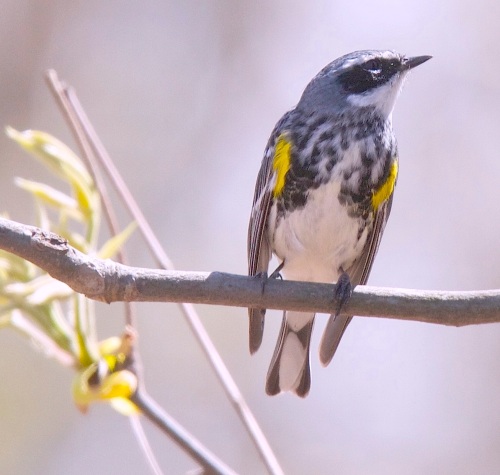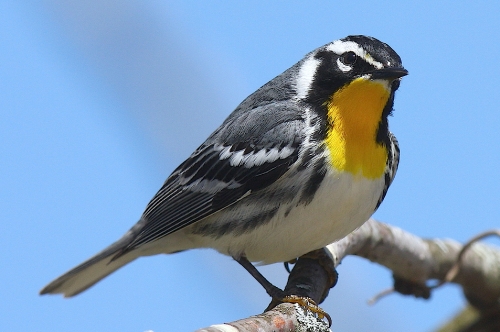We need the rain but not the Severe weather:
Archive for April, 2013
Eyes to the Skies – 4/17 and 4/18
Posted in Weather, tagged 4/17/13, 4/18/13, severe weather boston mountains on April 17, 2013| Leave a Comment »
Pretty male Yellow Rumped Warbler Series
Posted in Wild Birds, tagged 14th, 2013, april, Arkansas, male, murray valley, nature, parthenon, photography, yellow rumped warbler on April 16, 2013| Leave a Comment »
He appeared Sunday and I got off about 40 shots at a very long range with a 840mm Lens:
Yellow-rumped Warblers are impressive in the sheer numbers with which they flood the continent each fall. Shrubs and trees fill with the streaky brown-and-yellow birds and their distinctive, sharp chips. Though the color palette is subdued all winter, you owe it to yourself to seek these birds out on their spring migration or on their breeding grounds. Spring molt brings a transformation, leaving them a dazzling mix of bright yellow, charcoal gray and black, and bold white.
-
Size & Shape
Yellow-rumped Warblers are fairly large, full-bodied warblers with a large head, sturdy bill, and long, narrow tail.
-
Color Pattern
In summer, both sexes are a smart gray with flashes of white in the wings and yellow on the face, sides, and rump. Males are very strikingly shaded; females are duller and may show some brown. Winter birds are paler brown, with bright yellow rump and usually some yellow on the sides.
-
Behavior
Yellow-rumped Warblers typically forage in the outer tree canopies at middle heights. They’re active, and you’ll often see them sally out to catch insects in midair, sometimes on long flights. In winter they spend lots of time eating berries from shrubs, and they often travel in large flocks.
-
Habitat
In summer, Yellow-rumped Warblers are birds of open coniferous forests and edges, and to a lesser extent deciduous forests. In fall and winter they move to open woods and shrubby habitats, including coastal vegetation, parks, and residential areas.
Time to use snake boots or snake gaiters when bushwhacking
Posted in Reptiles and Amphibians, tagged animals, Arkansas, Boston Mountains, copperhead, nature, nerwton county, outdoors, venomous on April 14, 2013| Leave a Comment »
Copperhead is venomous but shy. Surprised me !! Always startled by them, but I let him crawl on his way to a rock pile – they don’t get much bigger than this one (~ 40″). Be careful this spring:
Red-winged blackbirds are coming into the valley now
Posted in Wild Birds, tagged 2013, black feathers, blackbird, buffalo, cold weather, late spring, Little, Little Buffalo River, nature, red winged, red winged blackbirds, river, spring on April 13, 2013| Leave a Comment »
Despite the cold weather, and late spring, the red winged blackbirds are coming in flocks and roosting along the Little Buffalo River. I like this shot — because its hard to get a photo that distinguishes the back eye from the black feathers on this bird:
Luna Moth under a window
Posted in Moths and Butterfiles, tagged 4/10/13, Arkansas, large, Luna, moth, parthenon on April 12, 2013| Leave a Comment »
Must have been attracted to the light last night but is freezing in the 32F cold this morning. The moth is between 4 1/2″ and 5″ in length:
A beautiful Yellow Throated Warbler on 4/10
Posted in Wild Birds, tagged 2013, 600mm lens, april, Arkansas, canon 7d, little buffalo, Newton County, Pathernon, small songbirds, yellow throat, yellow throated warbler on April 11, 2013| Leave a Comment »
I saw this guy yesterdy prior to the rains. They are beautiful, small songbirds, and usually one of the first four warblers I see each year. Their actions are much line Nuthatches, in fact he was on my birdfeeder priior to flying to a tree and me getting this photograph. I had my Canon 7D with a 600mm Lens and got off a few shots bwefore I spooked him:
Adult Description
- Small songbird.
- Yellow throat and chest.
- Gray back.
- Black face connecting to stripes down sides.
- White eyestripe.
- White earpatch.
- Two white wingbars.
Immature Description
Similar to adult, but duller, and female may be washed brownish on back.
Redheaded woodpecker nesting; some eggs in the nest now
Posted in Wild Birds, tagged Arkansas, male feeding female, nesting, nestlings, parthenon, redheaded woodpeckers on April 9, 2013| Leave a Comment »
Last of a series until they begin feeding their nestlings in 15 or so days. The male is feeding the female during this period. She seems to leave only 10 minutes every hour at this point:
An Eastern Phoebe on Saturday also
Posted in Wild Birds, tagged Arkansas, common, early migration, eastern phoebe, eastern phoebes, flycatcher, grass nests, nature, outdoors, parthenon, plump songbird, wing feathers on April 8, 2013| 1 Comment »
These are birds with personality; some even stay in Arkansas all winter or return in late January. They can often be heard with a monotonus song “phoebe, phoebe, phoebe, phoebe …… phoebe” repeated over and over again.
Photo taken with a Canon 50D and a Canon 400 DO IS f/4.0 Lens.
One of our most familiar eastern flycatchers, the Eastern Phoebe’s raspy “phoebe” call is a frequent sound around yards and farms in spring and summer. These brown-and-white songbirds sit upright and wag their tails from prominent, low perches. They typically place their mud-and-grass nests in protected nooks on bridges, barns, and houses, which adds to the species’ familiarity to humans. Hardy birds, Eastern Phoebes winter farther north than most other flycatchers and are one of the earliest returning migrants in spring.
-
Size & Shape
The Eastern Phoebe is a plump songbird with a medium-length tail. It appears large-headed for a bird of its size. The head often appears flat on top, but phoebes sometimes raise the feathers up into a peak. Like most small flycatchers, they have short, thin bills used for catching insects.
-
Color Pattern
The Eastern Phoebe is brownish-gray above and off-white below, with a dusky wash to the sides of the breast. The head is typically the darkest part of the upperparts. Birds in fresh fall plumage show faint yellow on the belly and whitish edging on the folded wing feathers.
-
Behavior
The Eastern Phoebe generally perches low in trees or on fencelines. Phoebes are very active, making short flights to capture insects and very often returning to the same perch. They make sharp “peep” calls in addition to their familiar “phoebe” vocalizations. When perched, Eastern Phoebes wag their tails down and up frequently.
-
Habitat
These birds favor open woods such as yards, parks, woodlands, and woodland edges. Phoebes usually breed around buildings or bridges on which they construct their nests under the protection of an eave or ledge.
Redheaded Woodpeckers mating early this morning
Posted in Wild Birds, tagged 2013, Arkansas, in the early spring, nature, near, outdoors, parthenon, redheaded woodpeckers on April 8, 2013| 1 Comment »
More …… in this mornings thunderstorm, in a continuing series of the nesting of a redheaded woodpeckers near the Little Buffalo River just west of Parthenon:




















